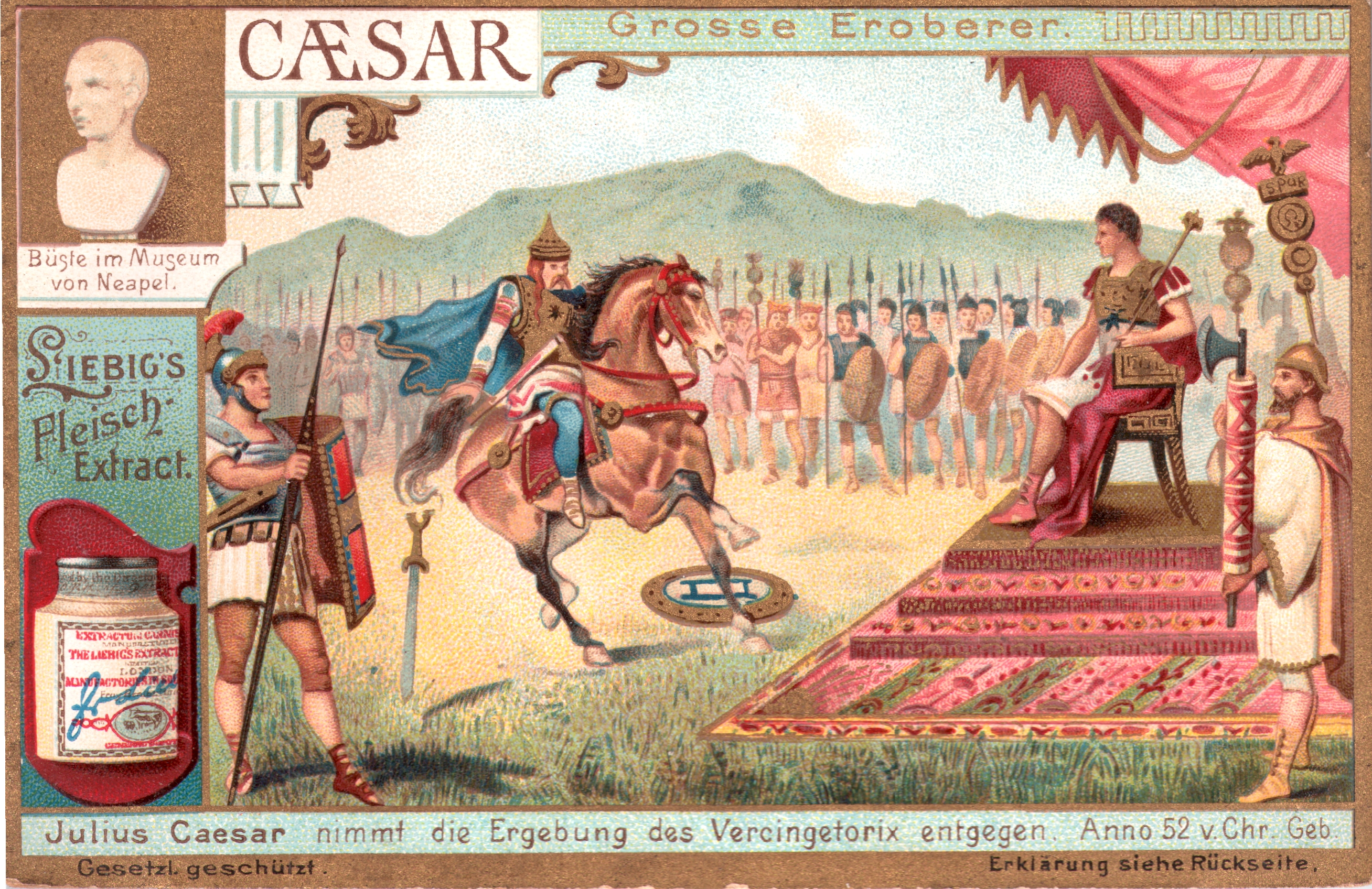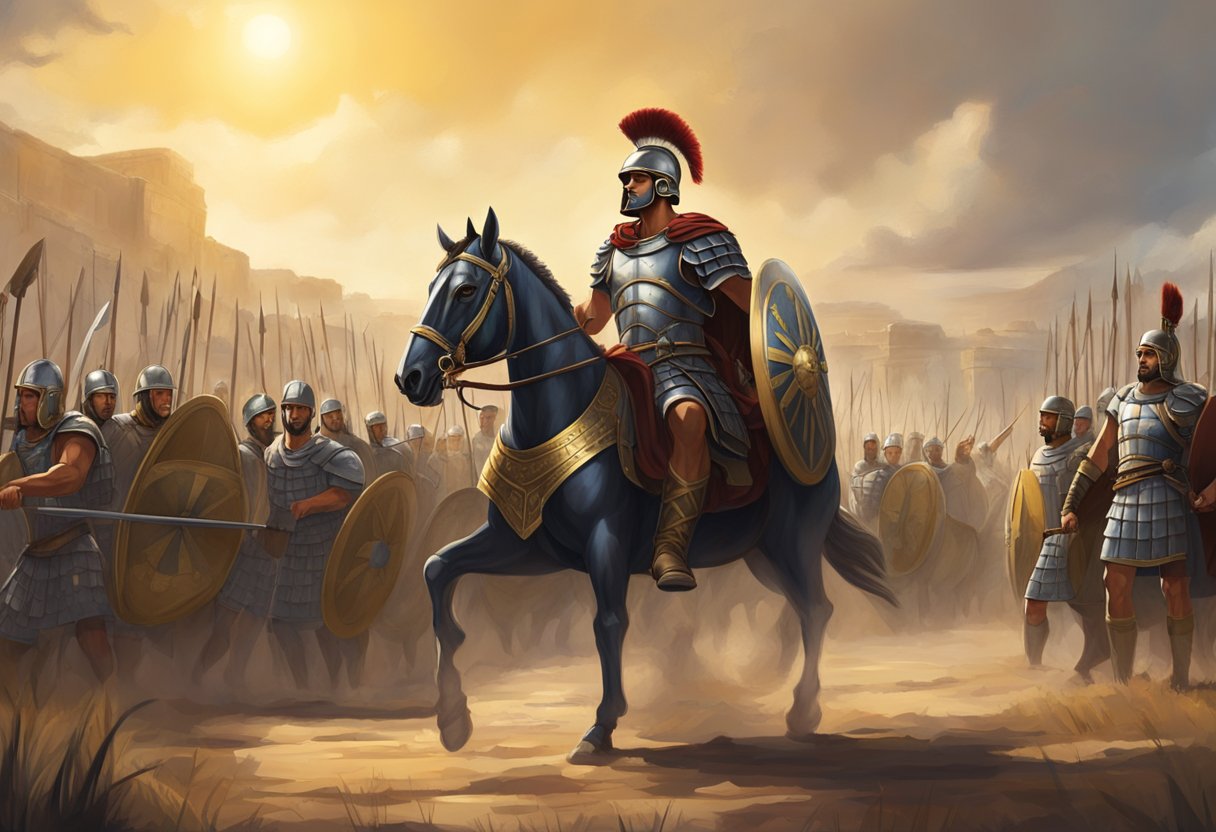Crixus, a name entwined with the legend of the Third Servile War, stands out in history as one of the most notable leaders of the gladiator uprising against the Roman Republic. As a Gaul, his journey from enslavement to becoming a gladiator and eventually an insurgent leader showcases the indomitable spirit of a man fighting for freedom.
Despite originating from the region broadly defined as Gaul, his early life remains shrouded in mystery, but his prowess and leadership became unmistakable as he rose through the ranks to challenge one of the mightiest empires of ancient times.

The Third Servile War, commonly known as the Spartacus Rebellion, saw Crixus at the forefront alongside Spartacus, commanding a horde of escaped slaves in a series of engagements that left Rome in a state of shock.
As a gladiator, Crixus had honed his skills in the arena, but his ambitions extended beyond personal glory to a wider struggle for liberation. While Spartacus is often credited as the primary leader, Crixus’s contributions were significant in shaping the early victories and strategic direction of the rebel forces.
His legacy is thus inseparable from the broader narrative of resistance against oppression and has resonated through various interpretations in arts and media, symbolizing the timeless quest for freedom.
Key Takeaways
- Crixus was a key leader during the Third Servile War, reflecting the strength and determination of the enslaved.
- His leadership and combat skills were pivotal in several early successes against Roman forces.
- Crixus’s story is emblematic of the enduring human struggle for liberty and has been immortalized in various cultural works.
Historical Context

The saga of Crixus weaves through the intricate tapestry of the Roman Republic‘s societal structures and the bloody sands of the gladiatorial arenas. His life story is inevitably tied to pivotal aspects of this era – the slavery system, the Gallic tribes, his own ethnic origins, and the prominent individuals of the Third Servile War.
Roman Republic and Gladiatorial Games
During the time of the Roman Republic, gladiatorial games became a quintessential element of entertainment and social order. These games were often held in grand arenas where enslaved gladiators fought, sometimes to the death, for the amusement of Roman citizens. The spectacle served both as a demonstration of Roman power and as a method for managing class tensions within the Republic.
Slavery in Ancient Rome
Slavery was an intrinsic part of Roman society, with the enslaved individuals working in households, farms, mines, and also as gladiators. A significant number of these slaves were war captives or people born into slavery. The harsh conditions often led to discontent, which set the ground for revolts such as the one led by Spartacus, in which Crixus was a key ally.
Gallic Tribes and their Significance
The Gallic tribes held significant roles in the Roman world, both as feared enemies and as subjugated peoples within the Roman sphere of influence. Their warriors were renowned for their ferocity in battle, and many were captured and forced into gladiatorial combat, adding to the exotic appeal of the games for Romans.
Crixus’s Ethnic Background
Known to be of Gallic origin, he was a living embodiment of the tension between Rome and the diverse ethnic groups under its rule. As a Gallic gladiator, his skills and fierce nature exhibited in the arena would have been seen as reflective of his heritage and would have contributed to his notoriety among Romans and Gauls alike.
Key Figures in the Third Servile War
The Third Servile War saw several key figures rise to prominence, including Spartacus, the Thracian gladiator who led the slave rebellion.
Alongside him were Oenomaus, Castus, and Gannicus, all of whom were vital in orchestrating the revolt. Crixus, as a major figure, diverged from Spartacus with a separate faction, emphasizing the complexity and the diverse objectives within the rebellion against the Roman Senate.
The Gladiator Uprising
Before the outbreak of the Third Servile War, an uprising began with a band of gladiators seeking freedom from oppression under the Roman Republic.
Escape from the Ludus
The rebellion began at the Ludus of Lentulus Batiatus in Capua, where gladiators, including the notable Crixus, seized their chance at liberty. After their daring escape, the gladiators procured weapons and armor to increase their odds of survival against any pursuit by the Roman Army.
Forming of the Slave Army
Post-escape, the group of freedom seekers traveled the countryside, swelling their ranks with slaves who longed to break their chains. This burgeoning slave army was initially unified under the leadership of Spartacus and his ally, Crixus, both former gladiators with formidable combat experience and a shared desire to evade the yoke of Rome.
Strategic Moves and Battles
The slave army, operating with strategic prowess, engaged in several confrontations against the Roman forces. They achieved a notable victory on the slopes of Mount Vesuvius, circumventing the Roman Army by using repurposed vines to descend the mountain and launch a surprise attack—a testament to their adaptability and tactical acumen.
Split with Spartacus
A rift eventually developed between Crixus and Spartacus, primarily over strategy and goals. Crixus, driven by a thirst for both revenge against Rome and continued plunder, clashed with Spartacus, leading to a separation of forces.
Unfortunately, the division weakened their collective power, and Crixus later met his death in battle against the Romans. His fighters were then crucified along the Appian Way as a dire warning to any future rebels against the might of the Roman Republic.
Crixus’s Legacy
Crixus – a name that echoes through the centuries as a symbol of defiance against oppression. As a key military leader alongside Spartacus in the historic slave rebellion against the Roman Empire, Crixus’s commitment to freedom left an indelible mark on history.
Posthumous Influence and Memory
After his death, he became an enduring symbol of resistance. As a leader of the rebel slaves, his legacy is often intertwined with that of Spartacus, serving as an inspiration for future uprisings and a testament to the human desire for liberty. Although he was ultimately defeated, the message of his struggle reverberated, suggesting that even the might of the Roman Empire was vulnerable to the will of the oppressed seeking revenge.
Representation in Culture
Crixus’s tale has been retold through various cultural lenses, embodying the timeless allure of a rebel hero challenging a much larger force.
The Starz Television Series Spartacus: Blood and Sand and its prequel Gods of the Arena cast Manu Bennett as Crixus, further shaping the public’s perception of him.
His character on-screen captures the warrior’s ferocity, strategic mind, and complex relationships within the gladiator school, creating a lasting image of the historical figure in modern media.
Contemporary Relevance
Even today, his story of seeking freedom from tyranny resonates deeply. It serves as a powerful representation of the struggle against systemic injustice, reminding us that history is often shaped by those who dare to defy the status quo. His experiences and the legend that surrounds him continue to engage audiences, providing a lens through which to view and critique contemporary issues of freedom and leadership.
Evaluation of Crixus’s Role in History
His role in the slave uprising against Rome carries significant historical significance. Although he and Spartacus ultimately met their downfall, their willingness to stand against a seemingly unbeatable foe spoke volumes about their commitment to the cause. His leadership paved the way for the rebel slaves, cementing him as a potent symbol of the human spirit’s undying quest for freedom and dignity in the face of overwhelming adversities.
Supporting and Allied Characters

In the unfolding narrative, the alliances and rivalries among characters play a pivotal role in shaping their destinies. A focus on Crixus, his camaraderie, and friction with other significant figures reveals the complexities of interpersonal relationships in his journey as a gladiator turned leader.
Spartacus and Crixus: A Comparison
Spartacus and Crixus begin as fellow gladiators bonded by a common desire for freedom, yet their approaches often vary. Spartacus is seen as the natural Leader, driven by a larger vision for liberation. Conversely, Crixus, although fiercely loyal, sometimes shows a more personal and immediate focus, particularly influenced by his relationship with Naevia. Their dynamic is critical, with Spartacus embodying the strategic mind and Crixus often serving as the passionate heart of the rebellion.
Notable Figures in Crixus’s Circle
Within Crixus’s inner circle, figures like Oenomaus, Gannicus, and Castus emerge as critical Allies. Oenomaus, a revered Gladiator and mentor, anchors Crixus with wisdom and discipline. His staunch demeanor and wealth of experience in the arena impart vital strategies for survival and success.
Gannicus, a free-spirited gladiator with unmatched skill in combat, eventually aligns with Crixus’s cause. His daring and charisma bring a dynamic edge to their combined forces. Castus, though less renowned than the others, contributes to the strength of Crixus’s contingent, demonstrating the breadth of his alliances.
Furthermore, Naevia evolves from a mere acquaintance to a pivotal figure in Crixus’s life, both as an emotional cornerstone and a warrior in her own right. Her transformation and bond with Crixus underscore the personal stakes within the turmoil of rebellion.
Barca, another gladiator, though not as central as the aforementioned figures, interweaves within this tapestry of allies, adding to the rich narrative of camaraderie and conflict that defines his world.
Adversaries and the Roman Response

The Roman Republic faced a significant threat from the slave rebellion led by Spartacus, in which he was a key figure. The uprising prompted a stern response from Rome. They deployed several generals and legions to suppress it, leading to crucial battles and political consequences within the Roman Senate.
Roman Generals against the Rebellion
Several Roman generals took the field to quell the insurrection, all experiencing varying degrees of success. Initially, Gaius Claudius Glaber failed to contain the slaves, as did Publius Varinius and Lucius Gellius Publicola, with the latter being defeated despite having the numerical advantage. This series of Roman setbacks underscored the resilience and tactical acumen of the slave army.
Marcus Licinius Crassus: The Ultimate Foe
Marcus Licinius Crassus became the pivotal figure in the Roman effort to end the rebellion. Wealthy and ambitious, Crassus saw the suppression of the revolt as a means to gain prestige and power.
He assembled a formidable force, and after a decisive encounter where Crixus fell, Crassus pushed the remnants of the revolt to the brink. His ruthless strategies, including the decimation of his own troops for discipline, illustrated the lengths to which Rome would go in response to such challenges to its authority.
Political Ramifications within Rome
The Senate’s reaction to the Spartacist upheaval was complex, with political maneuvering and power plays among Rome’s elites. The imperative to subdue the slaves was paramount, partly because a failure by any general often led to a loss of political standing in Rome.
The involvement of Julius Caesar, though peripheral in the conflict with Crixus, demonstrates the intersection of military action and political intrigue during the last years of the Republic. The slave rebellion, while eventually crushed, illuminated the fractures within the Roman political system and the Senate’s ever-anxious efforts to maintain stability and order.
Crixus in the Arts and Media

Crixus, the historical figure recognized for his role in the Third Servile War as one of the most prominent rebel gladiator leaders alongside Spartacus, has been immortalized in various forms of arts and media. These representations span from literary works to modern television series, each contributing to his lasting cultural impact.
Literary Portrayals
Historically, accounts of Crixus are found in the writings of Plutarch, Appian, and Florus. Plutarch, a Greek biographer and essayist, provides insights into the life and times of Crixus within the context of Spartacus’s uprising.
These accounts have informed many modern interpretations of his story. In fiction, Crixus features in the extended narrative poem by the British poet and artist David Jones, which is a detailed exploration of his character and experiences during the rebellion.
Film and Television Adaptations
The character of Crixus has been vividly brought to life by actors such as John Ireland in the 1960 film “Spartacus” and, most notably, by Manu Bennett in the Starz Television Series Spartacus: Blood and Sand. The Starz series elevated the legacy of Crixus through a visceral and dramatic portrayal that delved deep into his gladiatorial exploits and relationships, enhancing both his mythos and the series’ cultural impact.
Modern Depictions
The legacy of Crixus continues to inspire modern media. Jeff Wayne’s Musical Version of Spartacus, a combination of rock opera and spoken word, includes Crixus in its retelling. While these adaptations vary greatly in medium and approach, each pays homage to the gladiator’s role in history and examines themes of freedom and oppression that still resonate strongly in current times.
Comparative Analysis
Analyzing the historical context of rebel leaders reveals crucial insights into their tactics, motivations, and legacies. Among these leaders, he stands as a notable figure due to his role in the Third Servile War, commanding alongside Spartacus.
Crixus and Other Historical Rebel Leaders
Boudica: Like Crixus, Boudica was a formidable leader who rebelled against an oppressive regime. They both shared a deep resentment for their occupiers. However, while Crixus fought against the Roman Republic as a gladiator, Boudica led her Iceni tribe in a revolt against the Roman Empire.
Vercingetorix: Vercingetorix and Crixus both challenged the might of Rome, albeit in different eras and circumstances. While Crixus sought freedom from enslavement, Vercingetorix’s rebellion was driven by the desire to preserve the Gallic way of life. Each leader demonstrated strategic acumen, as Crixus was central to the key victories in the Third Servile War, and Vercingetorix is celebrated for his adept use of guerrilla tactics.
Spartacus: The parallel between Spartacus and Crixus is well-documented, with both being gladiators who led the revolt against their Roman captors. Their tactics and objectives were aligned until their strategic split. Crixus desired to continue the fight against Rome in Italy, while Spartacus is thought to have aimed to escape across the Alps. Despite their common goal of freedom, this tactical divergence led to separate paths and, eventually, their individual downfalls.
Conclusion
Crixus stands as a significant figure in ancient history, remembered for his prowess as a gladiator and a leader during the Third Servile War. His role alongside Spartacus in the fight for freedom from the oppressive Roman slave system marks a pivotal chapter.
His impact is evident in the field of entertainment, where his story has been retold through various mediums. As a leader, he displayed remarkable strategy and courage, characteristics that have cemented his legacy in both historical texts and popular culture.
The historical consequences of Crixus’ rebellion extended beyond his lifetime, challenging the Roman establishment and leaving a lasting imprint on the subsequent views on slavery and civil rights. While the rebellion he helped foster did not succeed in reforming the Roman slave system immediately, it sparked conversations and influenced future generations.
References
In evaluating the stock performance and forecast for Crixus BH3 Acquisition Company Class A Common Stock, multiple methods such as Transductive Learning (ML) and ElasticNet Regression techniques were employed. These methods are critical in creating prediction models for financial analysis.
You can read more about the forecast and stock predictions for the company at Crixus BH3 Acquisition Company Class A Common Stock Forecast & Analysis.
For those interested in investment opportunities regarding warrants, the Crixus BH3 Acquisition Company Warrants follow a similar scrutiny.
The predictive model for the warrants was evaluated using Multi-Task Learning (ML) alongside beta coefficients to draw conclusions about stock predictability.
Further details can be found at Crixus BH3 Acquisition Company Warrants.
The historical context of the name Crixus often relates to the fall of the Roman Capitol and can be traced to a figure boasting ancestral roots from the Brenni tribe.
Insights into this historical reference can be explored in academic literature, such as the study published within The Journal of Roman Studies.
Moreover, references to the term Crixus within the broader scope of Roman history and its cultural implications are also selective and frequent.
For a deeper understanding of the usage and mentions across historical texts, an examination of relevant literature may be beneficial. A curated reference can be viewed in literature available on Google Books.
People Also Ask:
In this section, key questions surrounding the historical figure Crixus are addressed, shedding light on his role in the Spartacus rebellion and his legacy.
How did Crixus die in the historical accounts?
Crixus perished in 72 BC, during one of the major battles of the Third Servile War, where Roman forces ultimately defeated his contingent, separate from the main body led by Spartacus.
What is the significance of Crixus in the Spartacus rebellion?
Crixus was a key military leader during the Spartacus rebellion, known for his bravery and combat skills. He played a pivotal role in several victories against Roman armies before his death.
Who was the historical figure that Crixus was romantically involved with?
Historically, there is little evidence regarding Crixus’s romantic involvements. However, some contemporary works of fiction, like the TV series “Spartacus”, portray him as being involved with Naevia.
What led to the conflict between Spartacus and Crixus?
The conflict between Spartacus and Crixus arose from differing objectives: Spartacus seemingly aimed for escape over the Alps, while Crixus reportedly sought to continue raiding Southern Italy.
In the show ‘Spartacus’, who is responsible for the death of Crixus?
In the show ‘Spartacus’, Crixus is killed by the Romans during a large-scale confrontation, specifically by the soldiers of Crassus who outmaneuvered the rebel forces.
What are some of the monumental tributes or statues dedicated to Crixus?
No well-documented tributes or statues dedicated to Crixus survive in contemporary records. His remembrance is primarily through literary and entertainment mediums.
